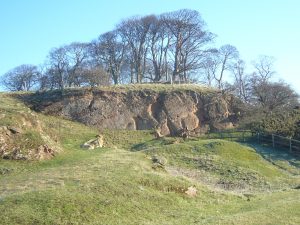Little Neston, Denhall and Ness Gardens
Walk 11 – Distance 3½ miles
Car parking at Marshlands Road
Bus service: Arriva 487 at the start or at Ness Gardens

- You can start from the junction of Marshlands Road with Homecrofts, Little Neston. Buses from Liverpool and Neston (487) stop here. Go down to the marsh, and immediately you have a view across the marsh, with curlews, gulls, and maybe little egrets in sight. To the right are the remains of the spoil heaps left by the Little Neston Colliery, which closed in 1928. Two notice boards, here and at Denhall Quay, summarise the history of the collieries.
- Turn left along Quayside, noting the vegetation left by the last high tide: each spring and autumn the highest tides cover the road. The Harp is on your left. On your right is Denhall Quay, where ships used to collect coal.
- The road now becomes a path. Until 2004 it was passable only in wellington boots, but Cheshire County Council surfaced it so you can walk in shoes, and we have been along it with a wheelchair. From 2013 it has been part of the Burton Marsh Greenway, (National Cycle Route 568). On a clear day you see the Halkyn hills and behind them the Clwyd range. Notice the flag poles, from which a red flag signifies that the Army are using their firing ranges. Sheep graze here except when a very high tide is due.
- Suddenly the path becomes a sealed road. This used to lead to the three Decca masts, but ships and planes use newer aids to navigation. Denhall House Farm has a fishery, and from 2013 Net’s Coffee Shop. Up to the left you can see part of the University’s Botanical Gardens also known as Ness Botanical Gardens which you will approach soon.
- The road now joins Denhall Lane. A small copse on the skyline ahead marks the site of the old Iron Age settlement of Burton Point Fort (a scheduled ancient monument). To the right is the Deeside Industrial Estate, built on land reclaimed by Summers’ Steel works, and the newest bridge across the Dee. Turn left up Denhall Lane, looking out for cars on this narrow steep lane. To the left is the entrance to Denna Hall, the former home of Richard Summers, a son of John Summers. To the right is Chapelfields, another scheduled ancient monument, and site of the Hospital of St John, now a lumpy field.
- The road crosses over the Bidston to Wrexham railway line, and up to Neston Road. Here you can catch a 487 bus to Neston or Liverpool, but a few hundred yards to the left is Ness Gardens. We usually call in for coffee and cake in the visitor’s centre.
- Along Neston Road you can walk through the Ness Gardens car park, to avoid a section of road with no footpath.
- In Ness village the sandstone on which we live comes to the surface. On the right is an anvil, commemorating the birth in Ness of Emma Lyon, later Lady Hamilton, whose father was a blacksmith. The Wheatsheaf Inn is ahead. You can walk a few yards to the right to see Swan Cottage, wrongly reputed to be the birthplace of Emma.
- Retracing your steps, turn down Well Lane past more native sandstone for fine views of the Dee estuary. On a clear day you can see the wind generators and drilling rigs out to sea.
- Later you pass Newhouses Lane, a footpath that goes down to Quayside. Well Lane takes you to Burton Road, which leads to St Michael’s church, where you turn left down Marshlands Road, under the railway and down to where you started.
